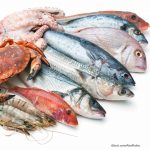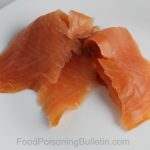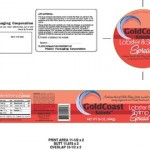Consumer Reports has published a special report about eating fish and mercury exposure. They say that to limit your risk, choose the right fish. And they advise pregnant women to avoid eating tuna altogether. They also recommend that anyone who eats 24 ounces or more of fish per week should avoid species high in mercury. Almost all seafood contains the toxic metal in different amounts. Too much mercury can damage the brain and nervous system, especially in children and fetuses. Adults who consume too much mercury can have problems with speech, sleep, walking, and fine motor coordination. More than 95% of the methylmercury in seafood is absorbed into your body when you eat it. Mercury levels in the northern Pacific Ocean have increased by 30% in the past 20 years, and are expected to … [Read more...]
Best and Safest Fish to Eat in the Summer
The Center for Food Safety is offering tips on the best and safest seafood to eat this summer. Most seafood sold in the U.S. is imported, and less than 2% of those products are inspected for contamination. Moreover, those fish are often caught in places where environmental and health standards are weak or non-existent. By eating locally caught, sustainable seafood, you are protecting your family from foodborne illness as well as potential problems from other contaminants such as PCBs and mercury. Buy local if possible, and choose wild over farmed. If the seafood is farmed, choose that produced in the U.S. Favor fish caught by hook, line, handling, jig, or speargun. Avoid trawl fishing, which is destructive to the environment. Avoid fish high in mercury, PCBs, or farmed fish that are … [Read more...]
FDA’s Plan to Allow Ionizing Radiation in Crustaceans Criticized
The FDA is amending food additive regulations to allow the "safe use of ionizing radiation on crustaceans" to control foodborne pathogens and extend shelf life. The petition to allow this method of controlling pathogens was submitted by the National Fisheries Institute. The government agency says the decision is based on potential toxicity, the effect of irradiation on nutrients and potential microbiological risk that may result from treating the fish. Crustaceans include crab, shrimp, lobster, crayfish, and prawns. Ionizing radiation is used to treat cancer patients and in X-rays and CT scans. At the maximum dose of 6.0 kiloGray, the treatment will "reduce, but not entirely eliminate" the number of pathogenic microorganisms on crustaceans. The update does state that "irradiation is … [Read more...]
California Warns Consumers Not to Eat Anchovies, Sardines, Crab
The California Department of Public Health is warning consumers not to eat commercially or recreationally caught anchovies or sardines or the internal organs of crab from Monterey and Santa Cruz counties. Dangerous levels of domoic acid have been found in some of these species and could be found in other species. Domoic acid is produced by phytoplankton, a type of algae, and accumulates in shellfish, sardines and anchovies. It is a biotoxin that affects the brain. Several people have died over the years and may others have become permanently disabled with brain damage after eating domoic acid contaminated seafood. The first reported outbreak of domoic acid poisoning was in 1987 at Prince Edward Island, Canada. Three people died and more than 100 were sickened in that outbreak after … [Read more...]
Consumer Groups Sue FDA Over Mercury in Seafood
Earthjustice, along with Center for Science in the Public Interest and the Mercury Policy Project, are suing the FDA for "failing to respond to a July 2011 petition in which the groups asked the FDA to give consumers clear, accurate, and accessible information about toxic mercury in the seafood they eat." At this time, the latest recommendations for pregnant women eating shellfish are to avoid certain species, and eat up to 12 ounces a week of other fish. Those recommendations were set in 2004. The lawsuit asks for a court-ordered deadline for the FDA to respond to its request that signs be required at seafood counters and on seafood labels to let consumers know how much mercury is in the fish they buy. The FDA had 180 days, three years ago, to respond to the petition, but did … [Read more...]
Skin Infections Reported From Handling Seafood in Chinatown
The New York City Department of Health and Mental Hygiene is reporting that people are getting skin infections from handling live or raw fish or seafood at certain markets in Chinatown. The rare infections are caused by the Mycobacterium marinum. The bacteria enters the skin through a cut or scrape, or if someone cuts themselves while handling the raw fish. The Health Department has identified 30 cases of this infection so far. All of the patients say they handled live or raw fish or seafood purchased at markets in Manhattan, Brooklyn, or Queens before the problem started. Symptoms of the infection include red, tender swelling under the skin of hands and arms, difficulty moving fingers, and pain in the hand or arm. To prevent these infections, wear waterproof gloves when you handle … [Read more...]
Food Safety Tips For National Seafood Month
October is National Seafood Month. Fish and seafood are a healthy part of a balanced diet and, as with all foods, proper handling and preparation are key to reducing the risk of food poisoning. Here are some tips from the U.S. Food and Drug Administration. Buying Fresh Fish Does something smell fishy? Don't buy it. Fish should not smell fishy, sour or like ammonia. Whole fish should have firm, shiny flesh; clear, slightly bulged eyes and red gills that are not slimy. Shrimp should also be odorless. And shrimp flesh should be shiny and translucent. Don't buy seafood that is not refrigerated or displayed on a bed of ice. Buying Fresh Shellfish Look for labels or tags on sacks of live shellfish. These tags have information such as the processor’s certification number, which … [Read more...]
FDA Offers Advice On Serving Seafood Safely
Serving seafood for your holiday gathering? The you may want to check out the tips on serving it safely from the U.S. Food and Drug Administration (FDA). Fish and shellfish are good sources of protein and nutrients, but handled improperly, they can cause illness. The first step in seafood safety is selecting wisely. Here's what the FDA recommends: Selecting Fish Don't buy fish that isn't refrigerated or displayed on a thick bed of fresh ice. Don't buy fish that has a strong odor. Do look for fish with clear, slightly bulging eyes. Do select fillets that have firm, shiny flesh that springs back when pressed. Don't buy fish that have milky slime in their gills. Don't buy fillets that are discolored or drying around the edges. Selecting Shellfish Do buy shrimp with … [Read more...]











